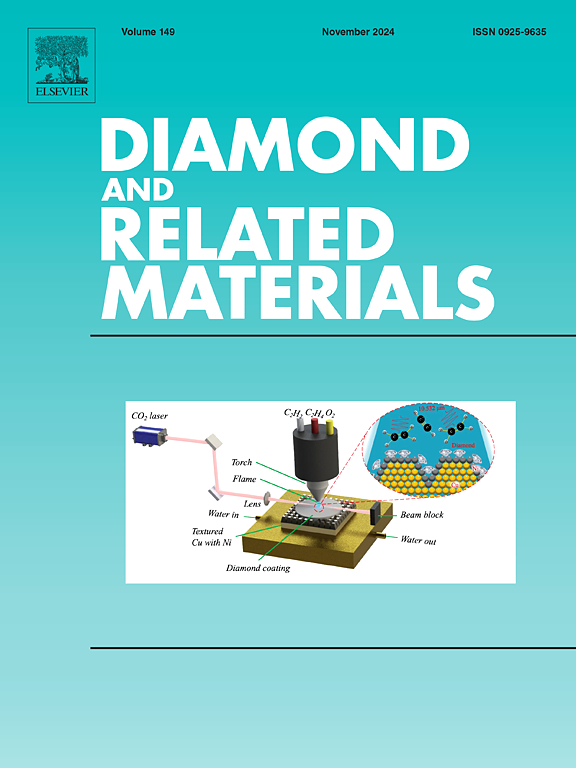二维六方氮化硼(h-BN)修饰在CeO2异质结纳米复合材料上改善光催化降解和抗菌应用
IF 5.1
3区 材料科学
Q2 MATERIALS SCIENCE, COATINGS & FILMS
引用次数: 0
摘要
二维(2D)材料已经证明了其作为光催化剂的非凡能力。本研究详细描述了采用液相剥离法制备的CeO2-h-BN异质结纳米复合材料。物理化学分析的结果表明纳米复合相的形成,伴随着振动、光学和表面元素映射的评估。通过有机染料亚甲基蓝在紫外-可见光下的光降解实验,考察了所制备的CeO2-h-BN纳米复合材料的光催化性能。与CeO2-h-BN纳米复合材料相比,CeO2的光催化测量值为58% h-BN 49%,在染料降解方面表现出出色的效率,在可见光下暴露140分钟后达到令人印象深刻的93%的最高效率。此外,CeO2- hbn纳米复合材料对革兰氏阳性和革兰氏阴性细菌都具有抗菌性能。这些结果突出了CeO2-hBN纳米复合材料在众多应用领域的广阔前景,值得进一步的研究和探索。本文章由计算机程序翻译,如有差异,请以英文原文为准。

Two-dimensional hexagonal boron nitride (h-BN) decorated on CeO2 heterojunction nanocomposite for improved photocatalysis degradation and antibacterial application
Two-dimensional (2D) materials have demonstrated remarkable capabilities as photocatalysts compared to their bulk versions. This research work meticulously describes the CeO2-h-BN heterojunction nanocomposites prepared via the liquid phase exfoliation method. The findings from the physicochemical analysis indicate the formation of a nanocomposite phase, accompanied by assessments of vibrational, optical, and surface elemental mapping. The photocatalytic properties of the prepared CeO2-h-BN nanocomposite were examined through the photodegradation of the organic dye methylene blue when exposed to UV–visible light. The photocatalysis measurements of CeO2, 58 % h-BN 49 %, compared to CeO2-h-BN nanocomposites exhibited outstanding efficiency in dye degradation, achieving an impressive maximum of 93 % after exposure to visible light for 140 min. Additionally, CeO2-hBN nanocomposites show antibacterial properties against both Gram-positive and Gram-negative bacteria. These results highlight the promising possibilities of CeO2-hBN nanocomposites for numerous applications, warranting further research and exploration.
求助全文
通过发布文献求助,成功后即可免费获取论文全文。
去求助
来源期刊

Diamond and Related Materials
工程技术-材料科学:综合
CiteScore
6.00
自引率
14.60%
发文量
702
审稿时长
2.1 months
期刊介绍:
DRM is a leading international journal that publishes new fundamental and applied research on all forms of diamond, the integration of diamond with other advanced materials and development of technologies exploiting diamond. The synthesis, characterization and processing of single crystal diamond, polycrystalline films, nanodiamond powders and heterostructures with other advanced materials are encouraged topics for technical and review articles. In addition to diamond, the journal publishes manuscripts on the synthesis, characterization and application of other related materials including diamond-like carbons, carbon nanotubes, graphene, and boron and carbon nitrides. Articles are sought on the chemical functionalization of diamond and related materials as well as their use in electrochemistry, energy storage and conversion, chemical and biological sensing, imaging, thermal management, photonic and quantum applications, electron emission and electronic devices.
The International Conference on Diamond and Carbon Materials has evolved into the largest and most well attended forum in the field of diamond, providing a forum to showcase the latest results in the science and technology of diamond and other carbon materials such as carbon nanotubes, graphene, and diamond-like carbon. Run annually in association with Diamond and Related Materials the conference provides junior and established researchers the opportunity to exchange the latest results ranging from fundamental physical and chemical concepts to applied research focusing on the next generation carbon-based devices.
 求助内容:
求助内容: 应助结果提醒方式:
应助结果提醒方式:


